Old Gilchrist Hall (1882)
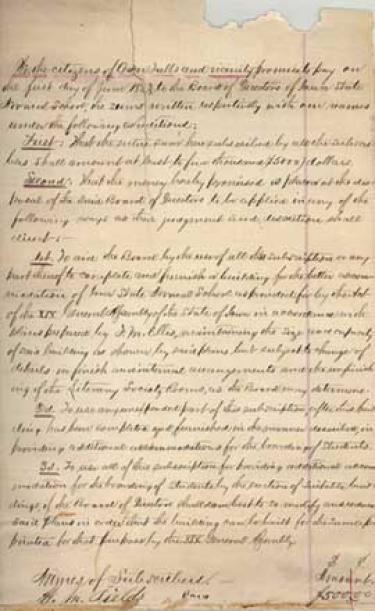
Just five years after its founding in 1876, the Iowa State Normal School had outgrown the original building, Central Hall, that it had inherited from the Orphans' Home. The student newspaper, The Students' Offering, noted in its February 1881 issue that, "We are crowded for room, and thus we are put to many inconveniences . . . ." The writer noted that students were trying to get the "benefit of difficulties" and hoping that the Iowa General Assembly would react favorably to funding a new building. Bills for a new building had been introduced in both 1878 and 1880 without successful outcomes.
Good news arrived in Cedar Falls a little over a year later. On March 11, 1882, students and faculty learned that both houses of the legislature had passed an appropriations bill that included $30,000 for a new building. Students held a mass meeting and planned a campus-wide celebration that would include a torchlight parade and music by the Cedar Falls Coronet Bend. Bad weather forced cancellation of the outdoor plans, but the March 1882 student newspaper published a long article on the significance of a new building.
It might be difficult now to understand why students, faculty, and townspeople were so excited. This new building, however, was not just another ordinary campus improvement. It was something special. For at least the first fifteen years of the Normal School's history, the continued existence of the school was a year-to-year proposition. There was no continuing appropriation for the school. At each session of the General Assembly, the Normal School budget, and, hence, its continued existence, started from scratch. Some legislators believed that a public school for the training of teachers was unnecessary. Other legislators did believe in normal schools, but they wanted the state to organize additional normal schools, preferably with a school in their own district. Funding a second building in Cedar Falls indicated that the legislature had a certain amount of confidence in the school. While the idea of additional normal schools would continue to surface in the legislature for many years to come, the appropriations bill showed that the state intended first to provide adequately for the Cedar Falls school before it founded new institutions.
Officials hoped that contracts for the new building could be let soon, with construction beginning yet in the spring of 1882. The target date for completion was the fall of 1883. As school concluded in June 1882, the Class of 1882 was already putting together material to be included in the cornerstone of the new building.
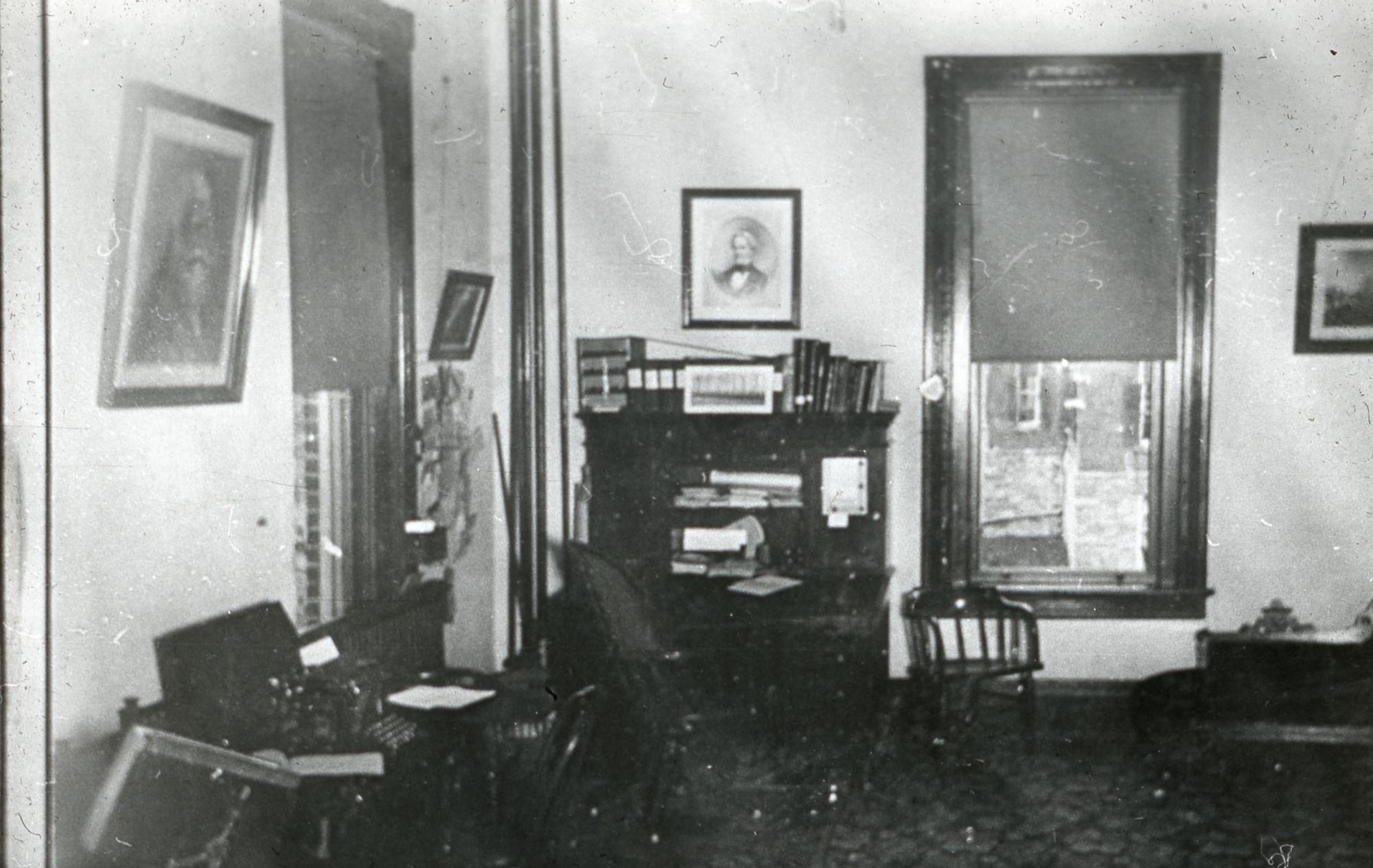
The Normal School Board of Directors moved forward quickly. At their March 30, 1882, meeting, they chose J. O. Ellis, a Marshalltown architect, to design the building. Mr. Ellis was to receive a fee not exceeding two and one half per cent of the cost of the building. His plans called for an expenditure in excess of the $30,000 appropriation, so the Board turned to local citizens to raise an additional $5000. By late June 1882, local citizens, businesses, and Normal School faculty had subscribed $5010. Included among the subscribers were Normal School Principal Gilchrist ($200), Professor Bartlett ($100), and Professor Wright ($100). At a time when faculty salaries were about $1000 per year, this was a remarkable example of generosity and a heartening display of faith in the institution.
The Board let a contract for $32,000. Ground was broken on June 29, 1882, at a site about one hundred feet south and just a little east of the original Orphans' Home building. The building would stand just east of where the Maucker Union is currently situated. The location of the new building in relation to the original Orphans' Home building led to its early name: South Hall. It would include a chapel capable of seating seven hundred; a model schoolroom; classrooms; laboratories; a library; literary society halls; and an apartment for Principal Gilchrist and his family. It would have steam heat, running water, and gas lights.
Controversy arose over the laying of the cornerstone of South Hall. Members of the Class of 1882 believed that they would be allowed to play primary roles in the ceremony, but the Board of Directors had arranged for the Masonic Order to have that honor. Despite hard feelings from the Class of 1882, the Masons did indeed preside at the cornerstone laying ceremony on August 29, 1882. The contents of that cornerstone are now in the University of Northern Iowa Archives.
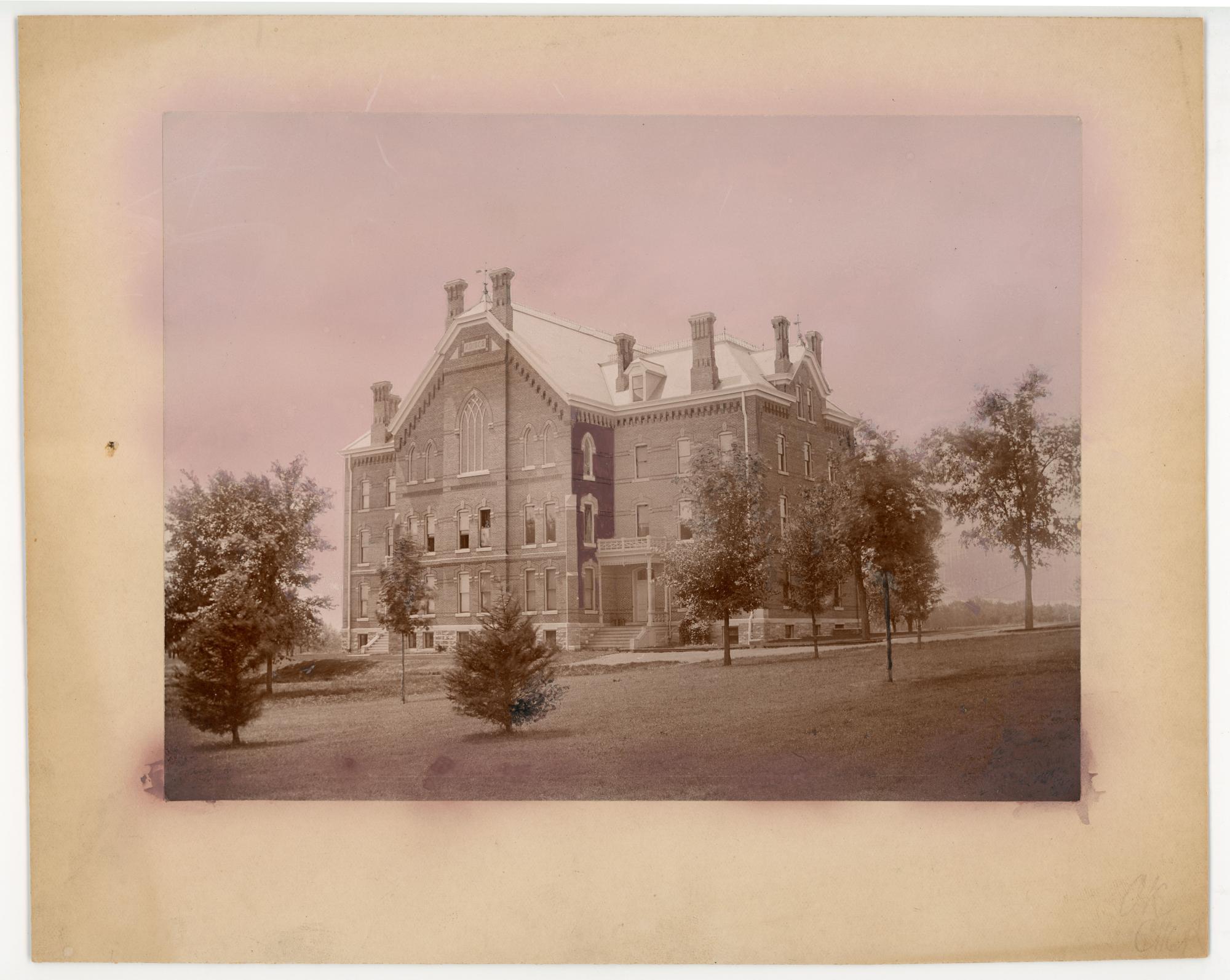
Construction proceeded smoothly. The October 1882 issue of The Students' Offering reported that the brickwork was already complete above the second story. Workers used a horse drawn elevator to hoist bricks and mortar to the upper levels. Indeed, the construction site was something of a local marvel. People from Cedar Falls would drive out to see the work in progress. Cleland Gilchrist, a son of the Principal, is even reported to have come back to campus to assist with the project. In December 1882, the paper reported that, with the exception of the gables and chimneys, the exterior brickwork was complete. The slate for the roof was on site; roofing was scheduled to be done by Christmas. Then the workers could begin to concentrate on interior finish work.

By February 1883, about half of the lathwork had been installed. A crew was also preparing to put in the heating pipes, which would run from the existing power plant. During that spring, the Board of Directors prepared for the major effect that the new facilities would have on the school. Previously, the Normal School had been forced to keep its enrollment low due to severely limited classroom and boarding space: for example, in 1880, its enrollment was just 233. With the new building, the Board believed that the school could accommodate as many as four hundred students. By March, the steam pipes had been installed and the heat was turned on. This enabled the plasterers to get to work. Gas pipes were in place. Speaking tubes had been inserted into the walls to connect various parts of the building with the Principal's office.
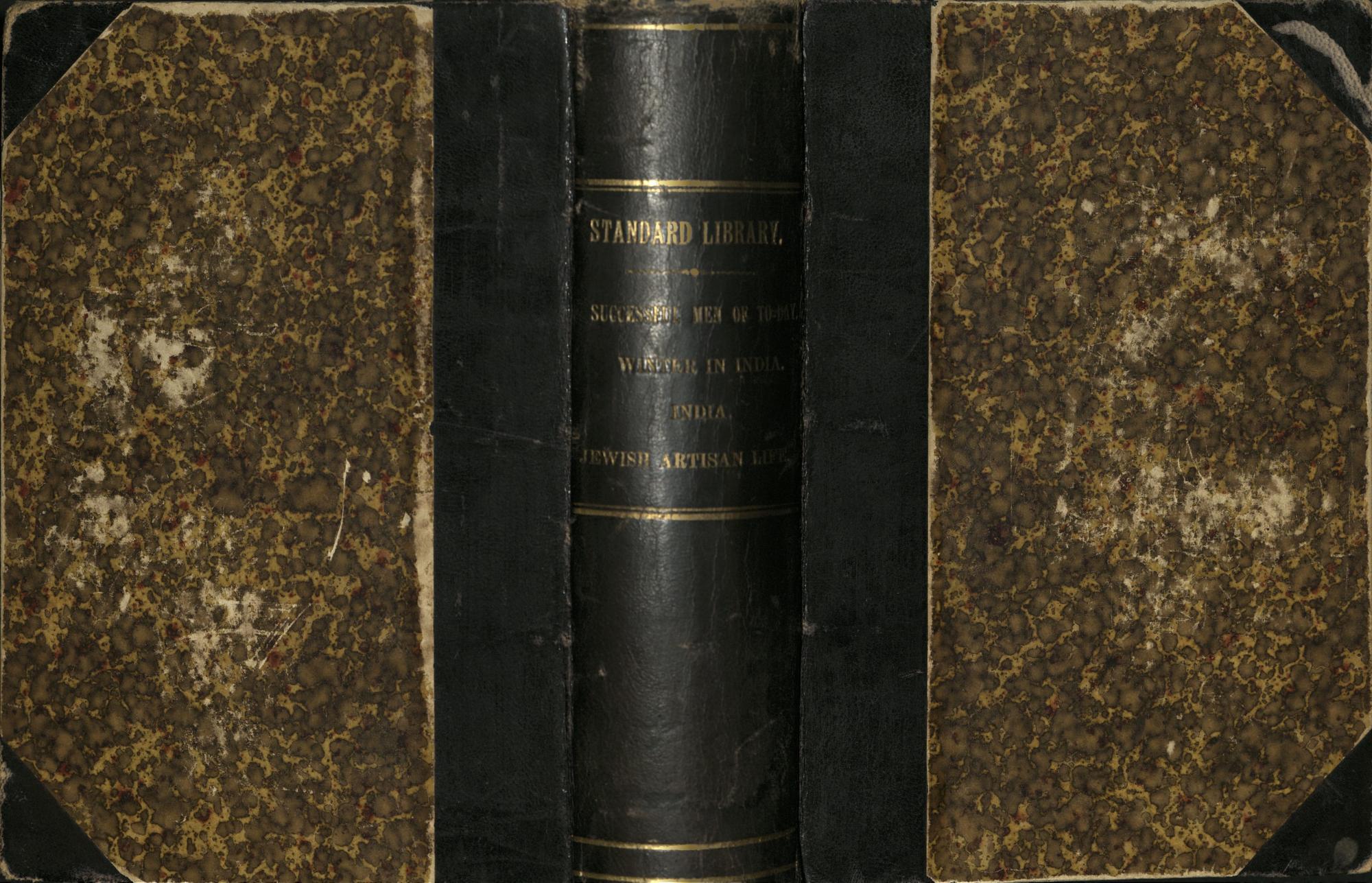
By May, the chapel was complete except for the seating. Frescoes added to the beauty of the room. Students were looking forward to the dedication of the building.
The building was dedicated on June 8, 1883. Governor Buren Sherman and Principal Gilchrist spoke at the dedication ceremony. During Commencement ceremonies on June 21, 1883, sixteen orators from the Class of 1883 received the honor of being the first to speak in the new chapel.
South Hall was ready for full use at the beginning of the fall term in September 1883. Both new and returning students must have been deeply impressed with the new South Hall. It had three stories plus an attic. Portions of the cellar were later excavated to provide additional space there. The central portion measured 45 X 78 feet with two wings each measuring 43 X 32.5 feet. The chapel was 76 X 45 feet and could seat seven hundred people. The capacity of the model school room was eighty. There was a library, chemical and physical laboratories, music rooms, offices, reception rooms, coat rooms, and six classrooms.
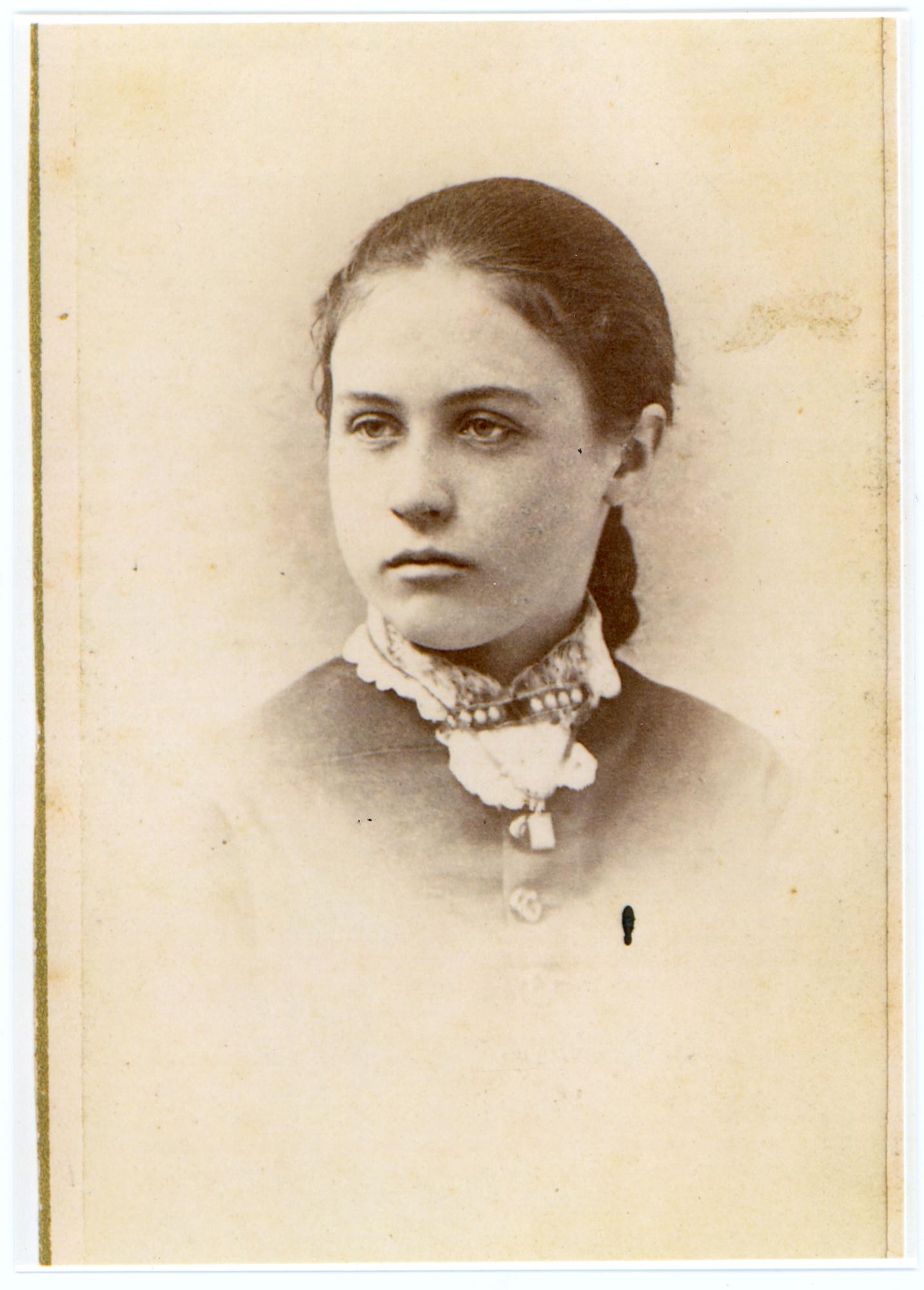
Dormitory space and the Principal's apartment, located on the second floor of the south wing, occupied the rest of the space. The building was equipped with furniture worth over $1000. South Hall was the first building constructed on campus specifically designed for the purposes of higher education.
The library, a "spacious and pleasant" room located in the south wing of the first story, was a matter of special pride. It contained about 1800 volumes on all subjects. Books on pedagogy, or education, were highlighted, but there was even some fiction "by the best writers." The school had, by this date, begun to acquire books of its own, but, in 1883, many of the books were from Principal Gilchrist's personal library.
To help staff the new facilities, the Normal School hired two additional teachers: Maude Gilchrist, the Principal's daughter, would teach natural science and mathematics; and Ella Ford Miller would teach the Model School, a precursor of the Laboratory School.
During the 1883-1884 school year, students and faculty continued to show support of their school by contributing $332 to pay for frescoes and a chandelier in the chapel.
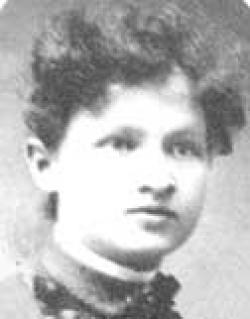
Principal Gilchrist resigned in 1886 and was succeeded by Homer Seerley, whose family continued to live in the South Hall apartment until the new President's Cottage, now known as the Honors Cottage, was completed in 1890.
In 1892, the Normal School used a portion of South Hall to expand its nascent program in what would eventually be called vocational education. A large basement room was set up as a carpenter's shop with benches and full sets of tools for both wood and metal work. The work would be part of a third year class associated with the study of physics. Students would learn basic and useful carpentry skills. What is more, women, specifically, were welcomed to the class!

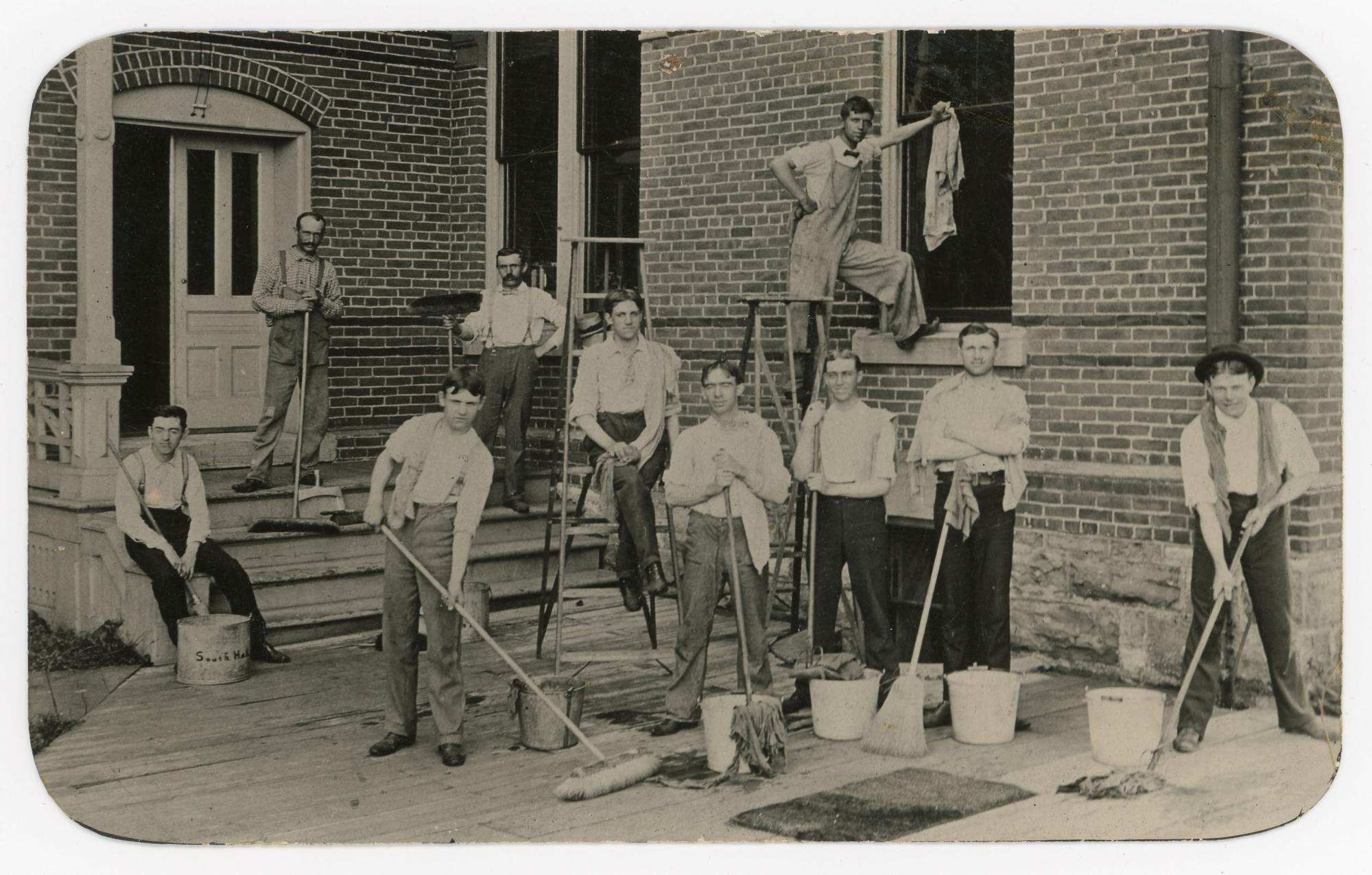
Also in 1892, the Normal School Board began discussion of building an elevated corridor between South Hall and North Hall to increase the efficiency of student passage at class change time. That bridge was built during the 1892-1893 school year. Students appreciated its shelter during inclement weather. Several years later, South Hall was linked by a ten foot wide, two story corridor to the newly completed Administration Building. The corridor entrances to South Hall were at the north ends of the old north-south hallways in that building.
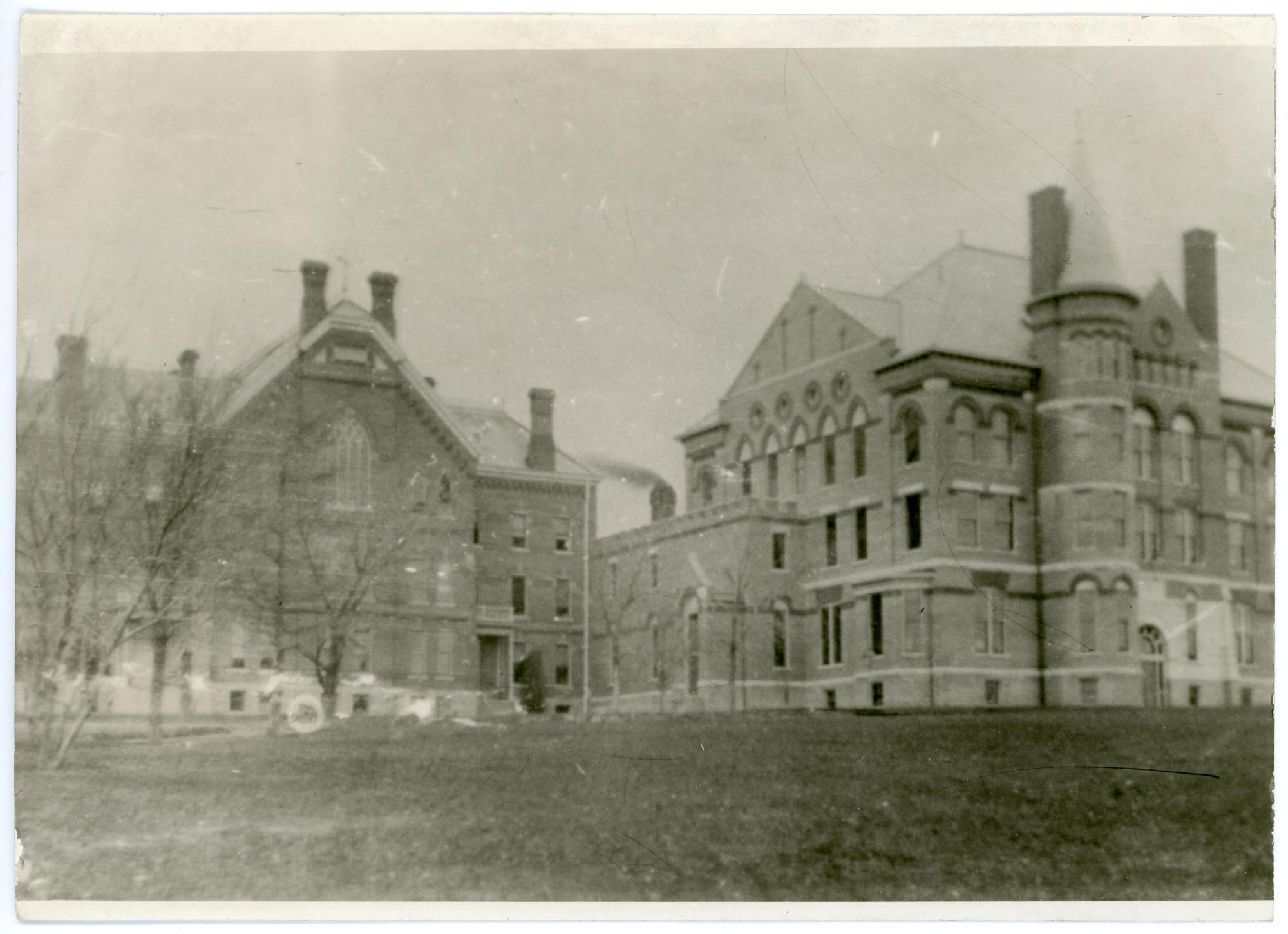
The early 1890s also saw the birth of the school band in South Hall. Jesse McLaughlin, Class of 1892, later recalled that he hated military drill, which was compulsory for men during his time at the Normal School. He tried to think of any possible way to avoid attending drill. He finally came up with the idea of forming a Cadet Band. He found about ten other men who were interested in the idea, but only a couple of them could actually play an instrument. Mr. McLaughlin approached President Seerley, who gave the group the use of a basement room in South Hall in which to practice. The group hired a tipsy local barber to teach them how to play. Ultimately, they were able to march and play, though they could not do both at the same time, in the Memorial Day parade in 1890.
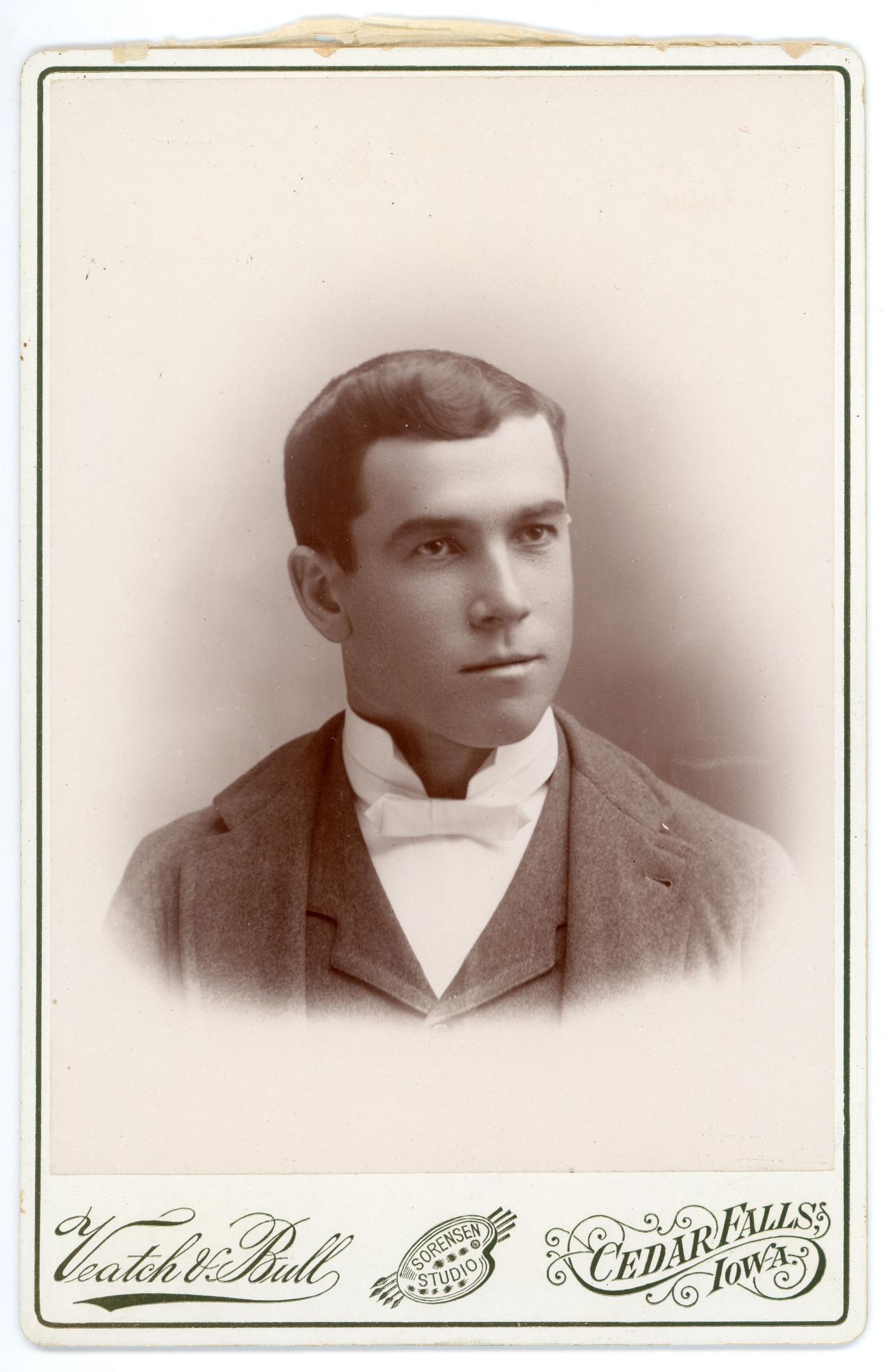
In 1896, South Hall received a round of repairs including patches to the ceiling and repapering of the walls. In the spring of 1897, the two north chapel windows, which apparently had been stained or colored glass, were replaced with clear glass to improve the lighting in the room. That fall President Seerley purchased a collection of reproductions of classic art and had them hung in the corridor between South Hall and the Administration Building. This may well have been the first art gallery at the school. In 1898, the Board authorized the installation of electric lighting in the chapel as well as additional work on the ceilings in South Hall, which seemed to have become a chronic problem. The new lighting was installed by the fall term. It consisted of "thirty-six incandescent lights of sixteen candlepower each . . . arranged on three circular reflectors suspended from the ceiling." The student newspaper commented that "They supply a long-felt need." It also significantly reduced the risk of fire in that area.
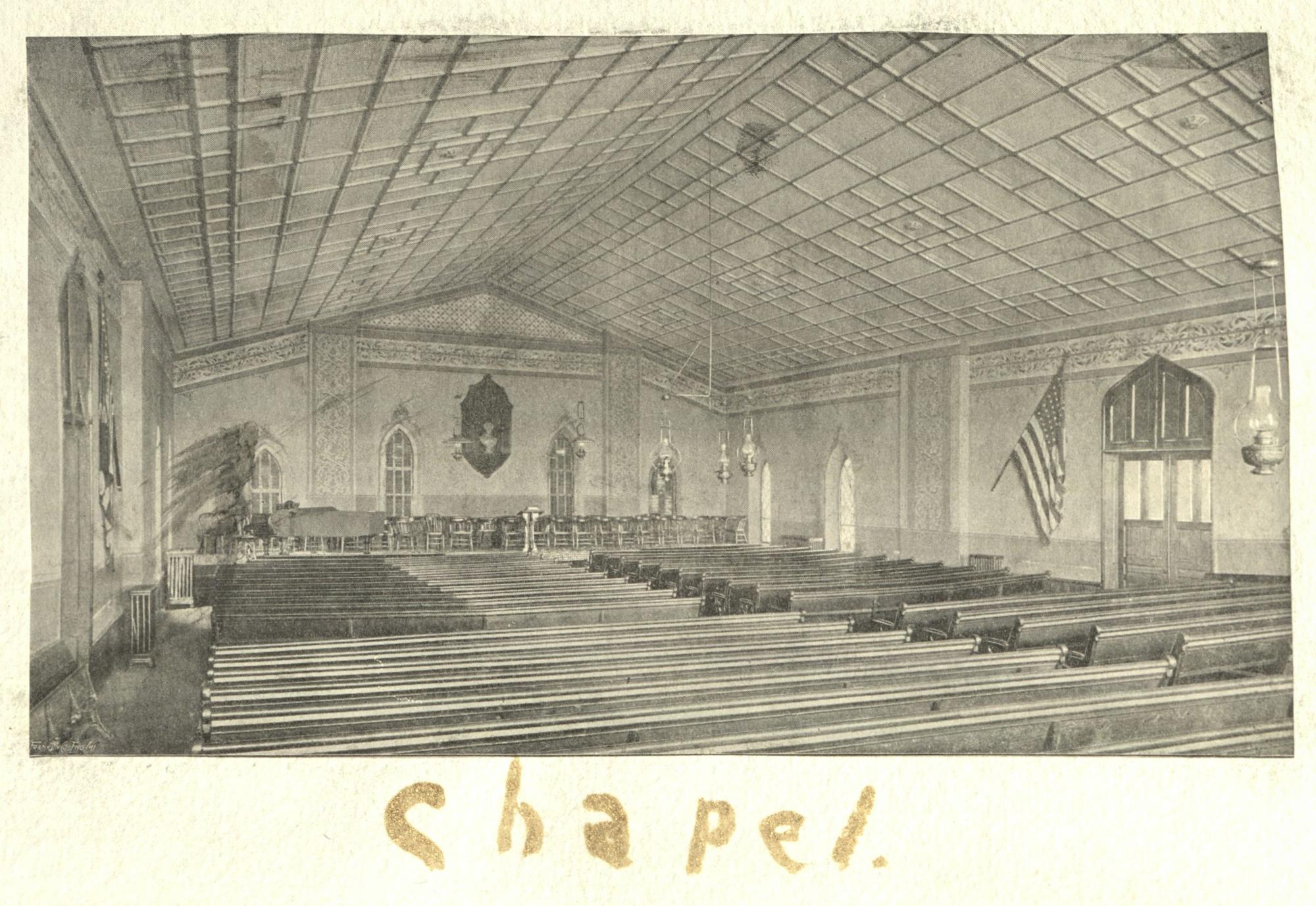
Beginning in December 1901, main chapel assemblies were held in the new Auditorium Building, now known as Lang Hall. The South Hall chapel had become very crowded as school enrollment grew. A fire in that third story room during an all-school assembly would have been disastrous. Thereafter, only much smaller divisions of the chapel meetings were held in South Hall. In 1904, in coordination with the construction of the new Gymnasium, the South Hall heating and ventilation system was re-fitted.
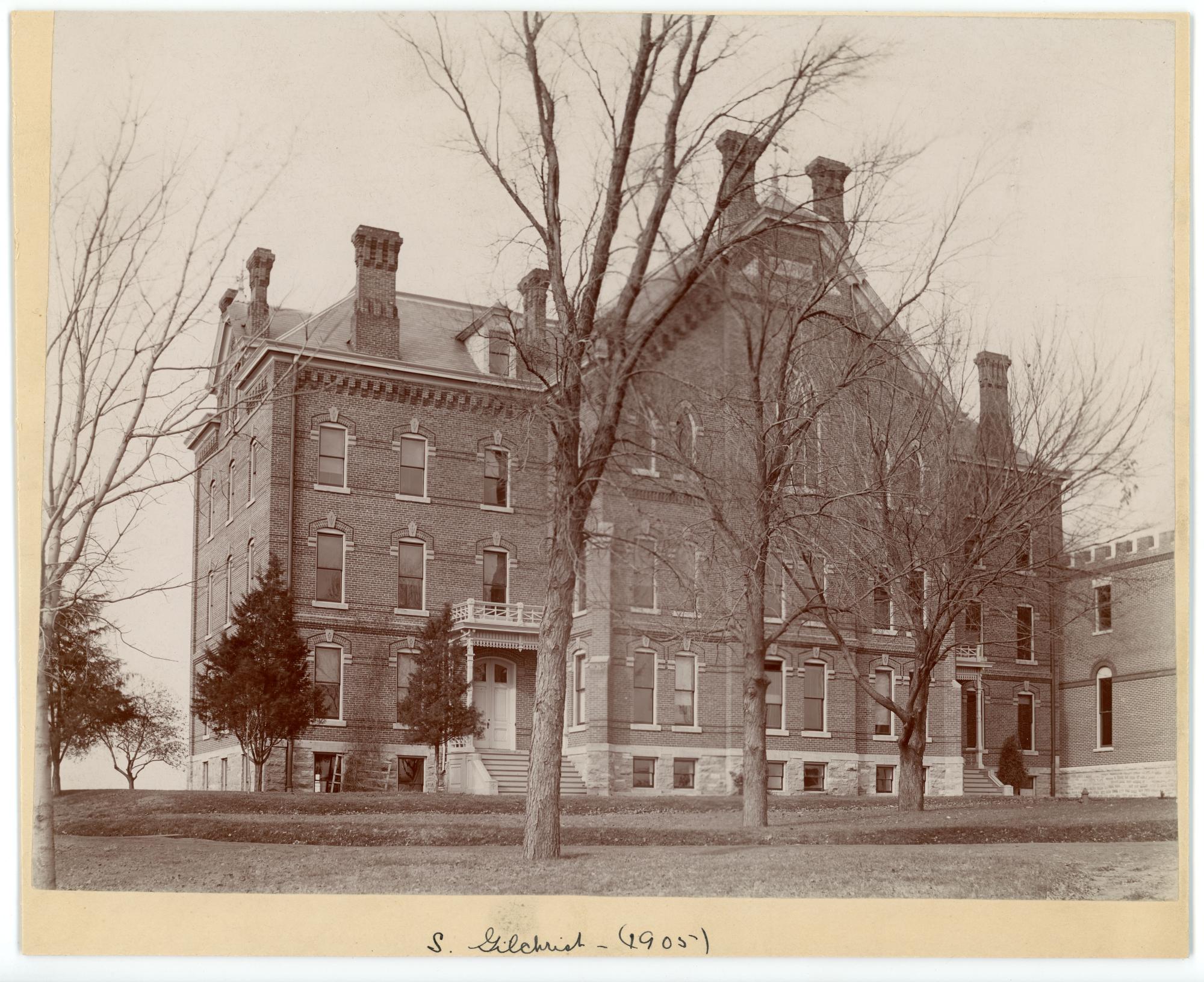
In 1915, South Hall received an official name when the State Board of Education chose to honor the first principal of the Iowa State Normal School, James Cleland Gilchrist. Principal Gilchrist served from 1876 to 1886 and actually lived in the building with his family for four years.
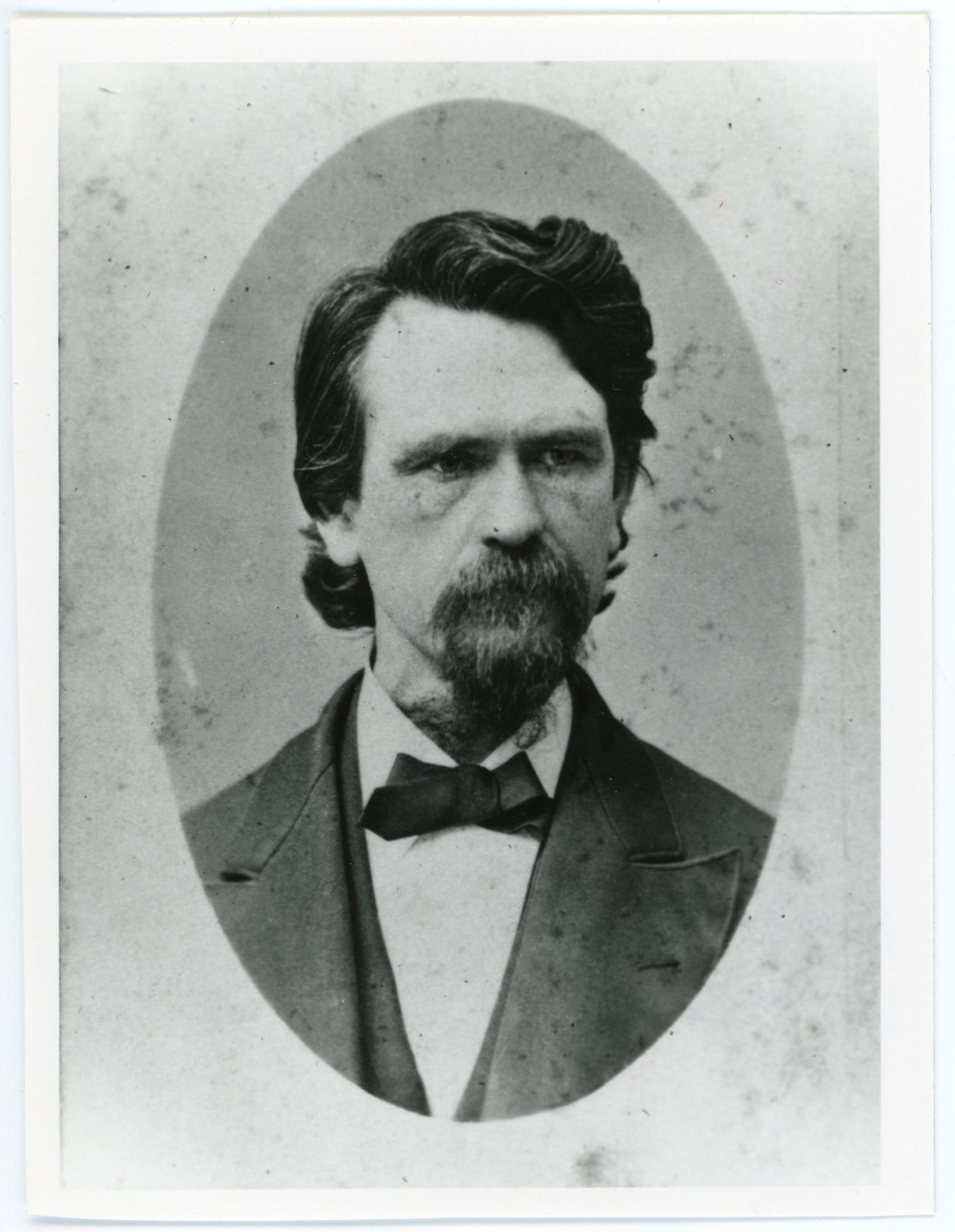
Gilchrist Hall and Bartlett Hall were the first two campus buildings to be named in honor of distinguished people. Prior to that time, buildings had functional or geographic names.
In 1919, the faculty received a new home for its meetings. Two rooms on the east side of the second story of Gilchrist Hall were remodeled into meeting space for the faculty and the Faculty Club. Larger meetings could still be held in the chapel. Likewise, the chapel could be used for musical and other kinds of performances that did not demand the seating capacity of the Auditorium. In 1923, the chapel was redecorated and a $2500 grand piano was installed there. The offices of both the College Eye and the Old Gold moved from Central Hall to Gilchrist Hall in January 1924.
In 1929 and 1930, during President Latham's drive for greater efficiency in college operations, office machine services were centralized in the basement of Gilchrist Hall. That room would house photostat, mimeograph, and multigraph machines, as well as staff to operate them. A new concrete floor was laid in the area and the walls were plastered and painted. At that same time, two classrooms in that building were remodeled into a six room suite for the new Dean of Women, Sadie B. Campbell. In addition, the Dean of Men moved from the Administration Building to Gilchrist Hall. President Latham also wanted to develop good public relations for the college. Consequently, he outfitted the College Eye office to be more like that of a professional newspaper, and he created a new Public Relations office under the direction of George Holmes. Both of these offices were in remodeled quarters in Gilchrist Hall. Late in 1930, the Extension Service offices in Gilchrist Hall underwent major remodeling with new equipment, lighting, floor coverings, and decoration.

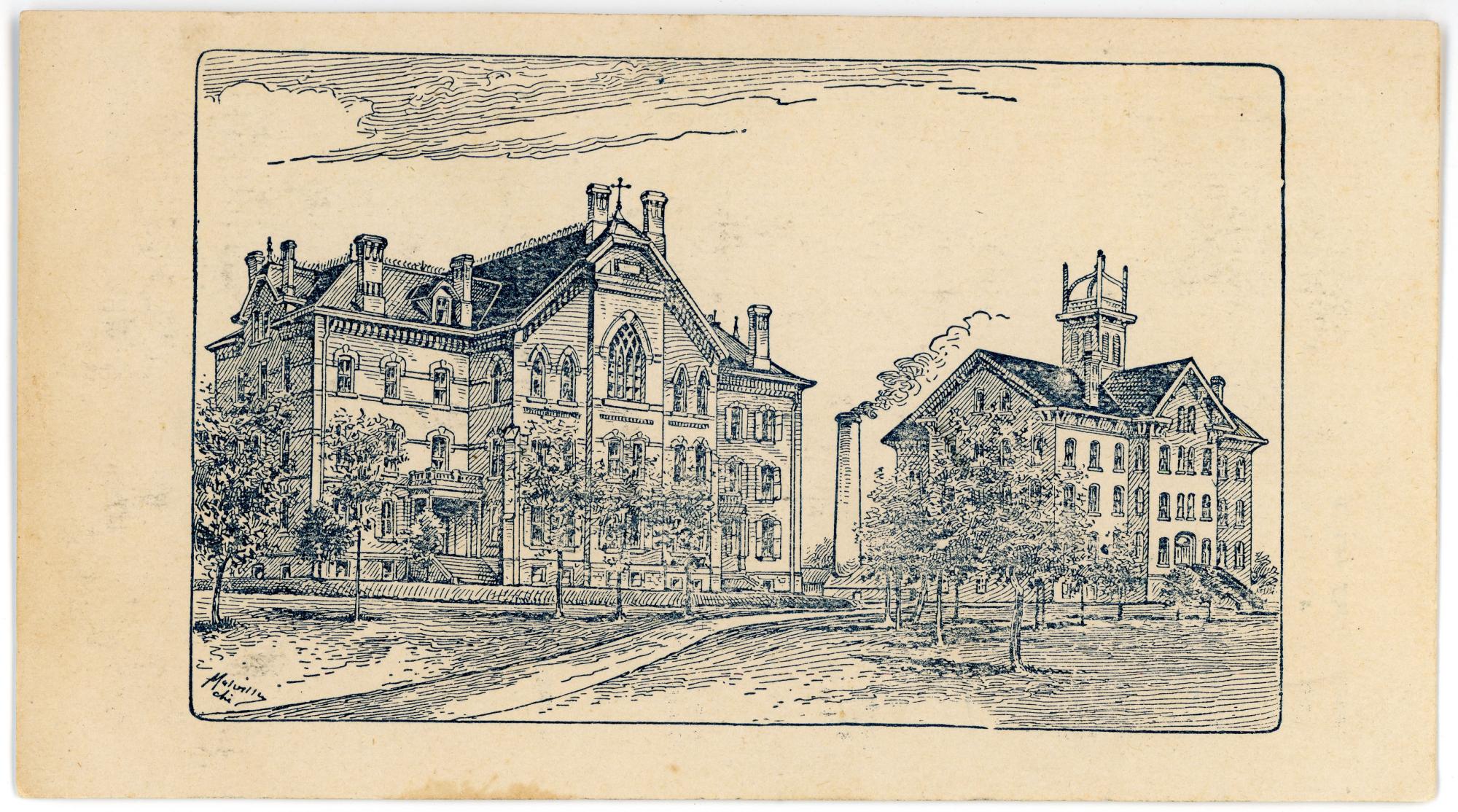
After this round of remodeling, the basement of Gilchrist Hall held mimeograph and paper storage rooms. The first story had the offices of the deans, the Extension Service, and the News Bureau. The second story included music studios, the College Eye and the Old Gold offices, and the faculty rooms. The third story included more music studios and the chapel. In the south wing of the attic, believe it or not, there was a golf practice room!
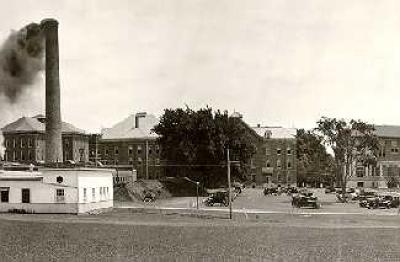
In the summer of 1931, the News Bureau moved up to the second story so that there was now a sort of Publicity Row, with the College Eye, the Old Gold, and the News Bureau in close proximity. College Secretary Benjamin Boardman moved into the space vacated by the New Bureau. His area included a new underground vault in which to store cash and important records. That fall, the Faculty Room received new drapes and carpet in a blue and gray color scheme.
The student publications area was upgraded again in 1934 with a new spatial layout, new offices, and a door between the newspaper and yearbook offices to improve communications between the staffs. There was also a new office for the Bureau of Alumni Affairs and a lounge for the secretarial staff, complete with a kitchenette and a dressing room. During this same period, the large parking lot west of Gilchrist Hall was removed and landscaped. Some students protested this loss of convenient parking.
During the summer of 1935, an extensive renovation project began in the Gilchrist Hall chapel. Carpenters installed new, sloped flooring. A stage, 24 X 16 feet, was built at the west end of the chapel. The stage featured footlights, velour curtains, a proscenium, and stage doors on each side. The old pew style seating was replaced by 294 upholstered opera style seats. The remaining stained glass window on the east side of the chapel was replaced with clear glass. All windows were hung with draperies. Two large ceiling fixtures and six wall fixtures provided light. The walls were replastered and painted an ivory cream color. The birch trim was stained dark. Panels installed on the walls improved acoustics. The cost of the project was about $6000.
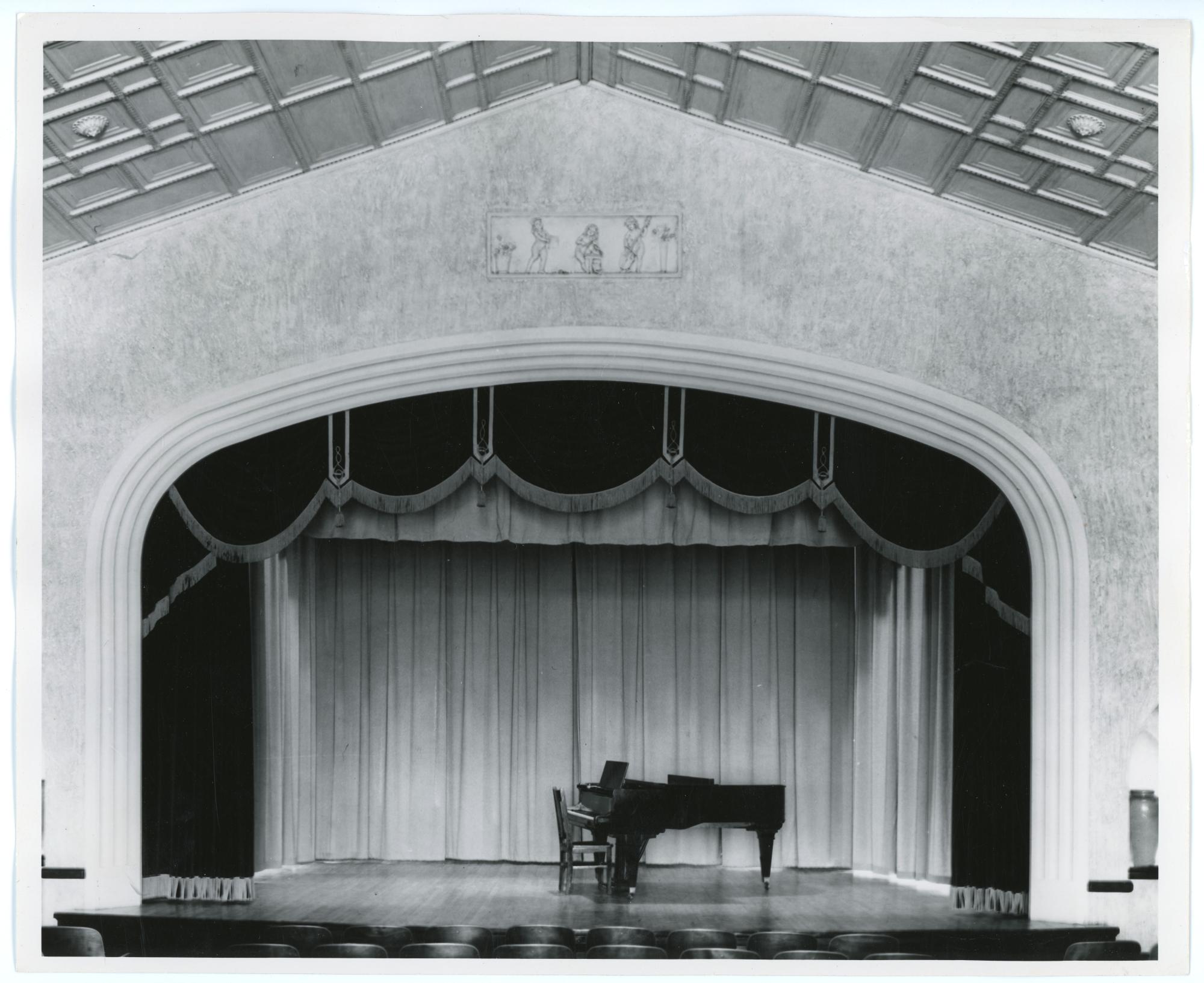
The transformation of the chapel from its original and intended church-like appearance to a little theater or small auditorium was complete just after Christmas, 1935. Music students Eloise Harmon, Erma Brouhard, Esther Miller, Jane Eby, and Frank Quinn performed the first recital in the new room on January 9, 1936. The room continued to be called the Gilchrist Chapel, but it was used mostly for debates, recitals, and other kinds of performances.
In the summer of 1942, Gilchrist Hall was tuckpointed to repair deteriorated mortar. During the work, the tower and several of the tall chimneys were removed. In 1944, additional interior lights were installed in the building.
In 1947, President Price outlined his plans for the future of the Teachers College. A decade earlier, at the program for the school's sixtieth anniversary celebration in 1936, a visiting speaker noted that Gilchrist Hall was "unattractive and in peril of fire." He recommended that it be replaced. President Price echoed those concerns; he stated that Gilchrist Hall, Central Hall, and the Administration Building should be replaced. Such changes, of course, could not occur overnight.
In 1948, the Business Office expanded its quarters in Gilchrist Hall. In 1950, the Extension Service received additional space in the building to sort and store its publications. In February 1954, the Faculty Room underwent renovation. The old pressed metal ceiling was removed, drapes were installed, and the whole room was painted. In addition to serving as the site of faculty meetings, the room also served as headquarters for debate tournaments, local conventions, and occasional social gatherings.
But also in 1954, an editorial writer in the College Eye called Gilchrist Hall, along with the Auditorium and the Administration Buildings, "old and unworthy of habitation." In 1956, Registrar Marshall Beard did not use quite the same tone, but he did make it clear that Gilchrist Hall was slated for removal. In the mean time, the building continued to house many important offices, services, and programs including the Business Office, the offices of the Deans of Women and Men, the Old Gold office, the College Eye office, public relations, music practice rooms, and even the college archives, before that program became associated with the library.
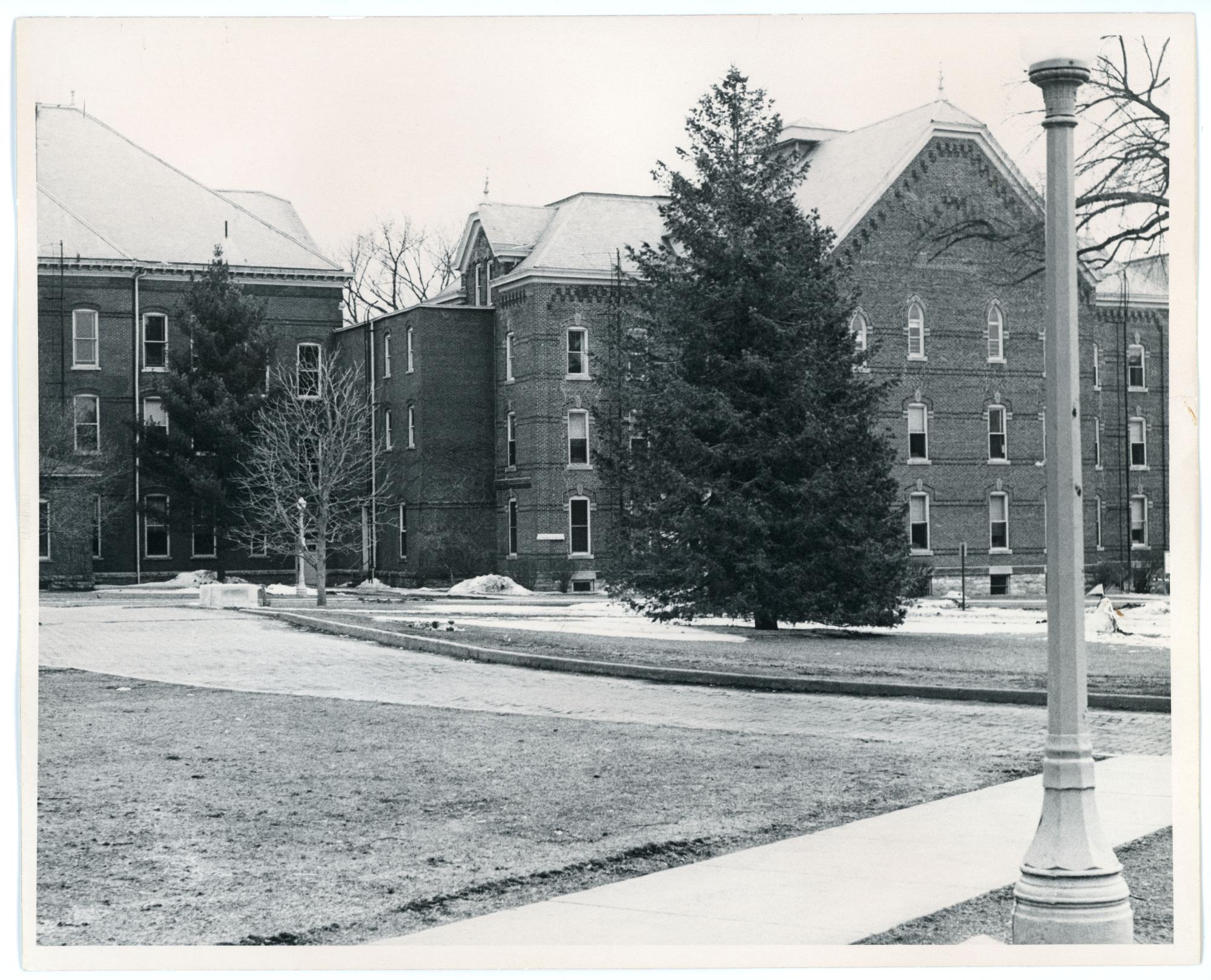
In February 1962, the new Music Building, now known as Russell Hall, opened. Music offices and practice rooms that had been in Gilchrist Hall moved to the new building. Faculty from the Department of Education and Psychology moved into the vacated space in Gilchrist Hall. One room would be used as a Public Relations photography lab.
Even though Gilchrist Hall was clearly not in the plans for the future of the college, the fire that destroyed Central Hall on July 22, 1965, made at least a few people begin to think about the school's historical heritage. In an editorial entitled "Tradition--worth the effort?", in the November 16, 1965, issue of the College Eye, a writer said, in part:
- "Before curtly dismissing Gilchrist Hall as an architectural monstrosity, a campus blot, and bulldozing it over, it would be wise to consider--if only briefly--its value as a symbol. Despite its unfortunate location and condition, it remains as SCI's best symbol of the continuity of past, present, and future, a symbol of solidarity. It is a sign of what this school has been, the progress that it has made; it is assurance that this college has served well in the past and will continue to serve well in the future. But to suggest salvaging Gilchrist and Administration is bucking a strong current . . . ."
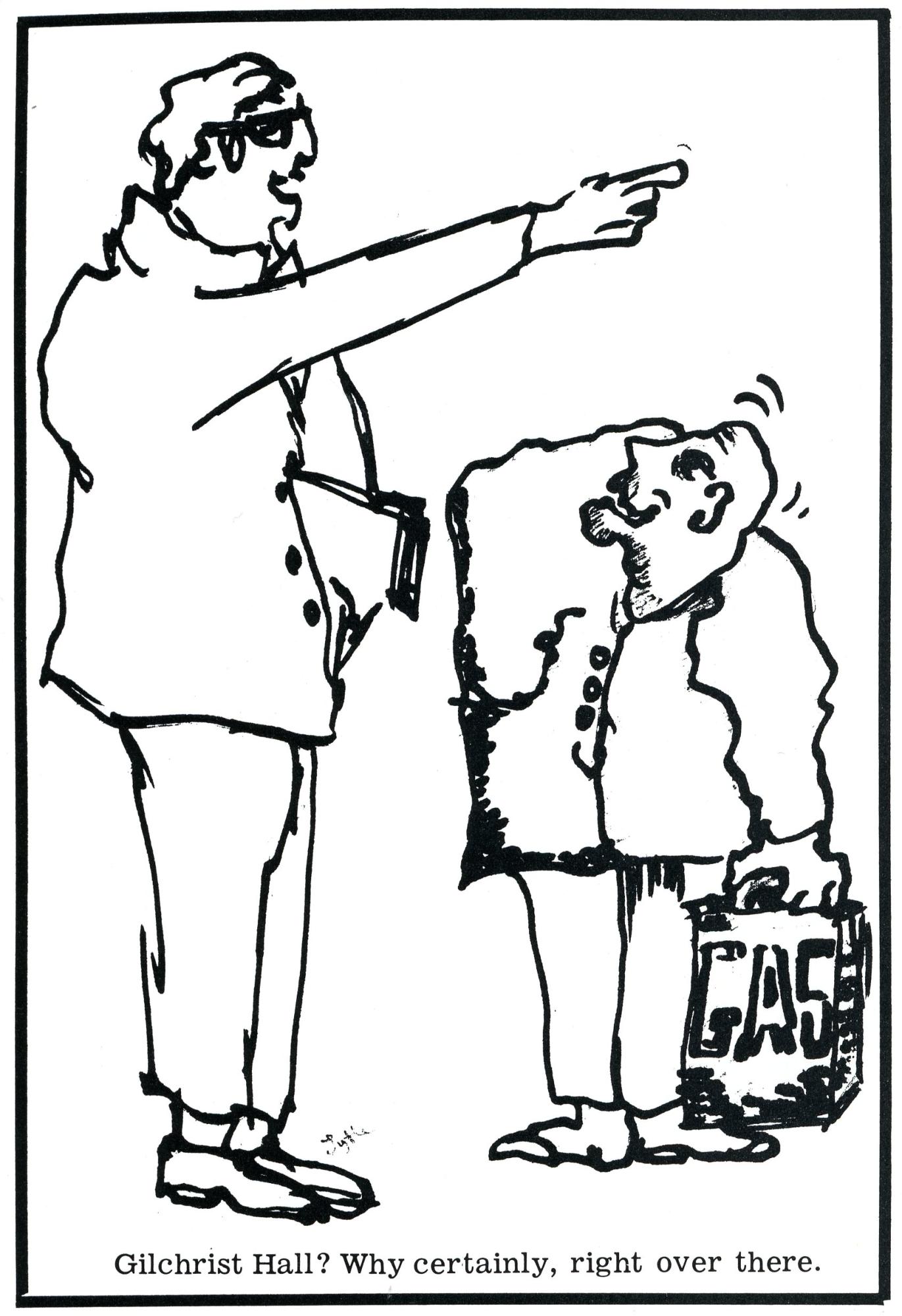
A harbinger of things to come occurred on Sunday, March 19, 1967. A group of students working in the College Eye office in Gilchrist Hall smelled smoke. They looked around the office area with the help of a campus security officer. They could not locate the source of the smoke until a student felt a drop of liquid hit him on the head. The group then quickly identified a shorted light fixture transformer, whose wax seal had begun to melt. They quickly switched off the light. Had the short not been located, it could have led to a disastrous fire.
But the school was not quite through with Gilchrist Hall. In the summer of 1969, the chapel was converted into a large lecture hall. Cuts in the university's budget later that year seemed to extend the life of the building even further. Delays in the funding of new construction indicated that Gilchrist Hall could not be razed until 1982.
There was yet another foreshadowing of the demise of Gilchrist Hall in a cartoon that appeared in the UNI Quarterly in 1970.
On May 12, 1972, faulty electrical wiring in Gilchrist Hall caused a fire that destroyed much of the building.
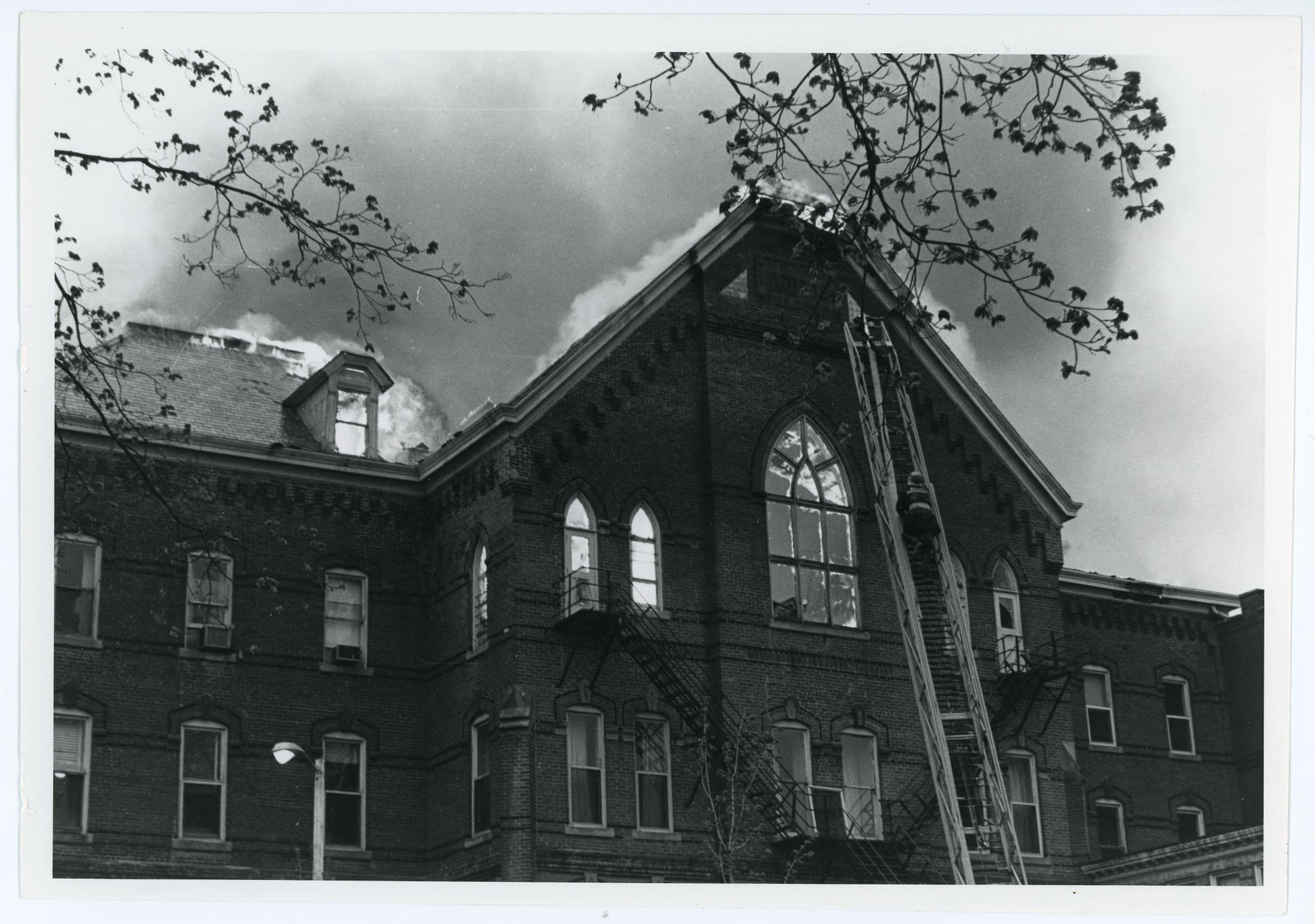
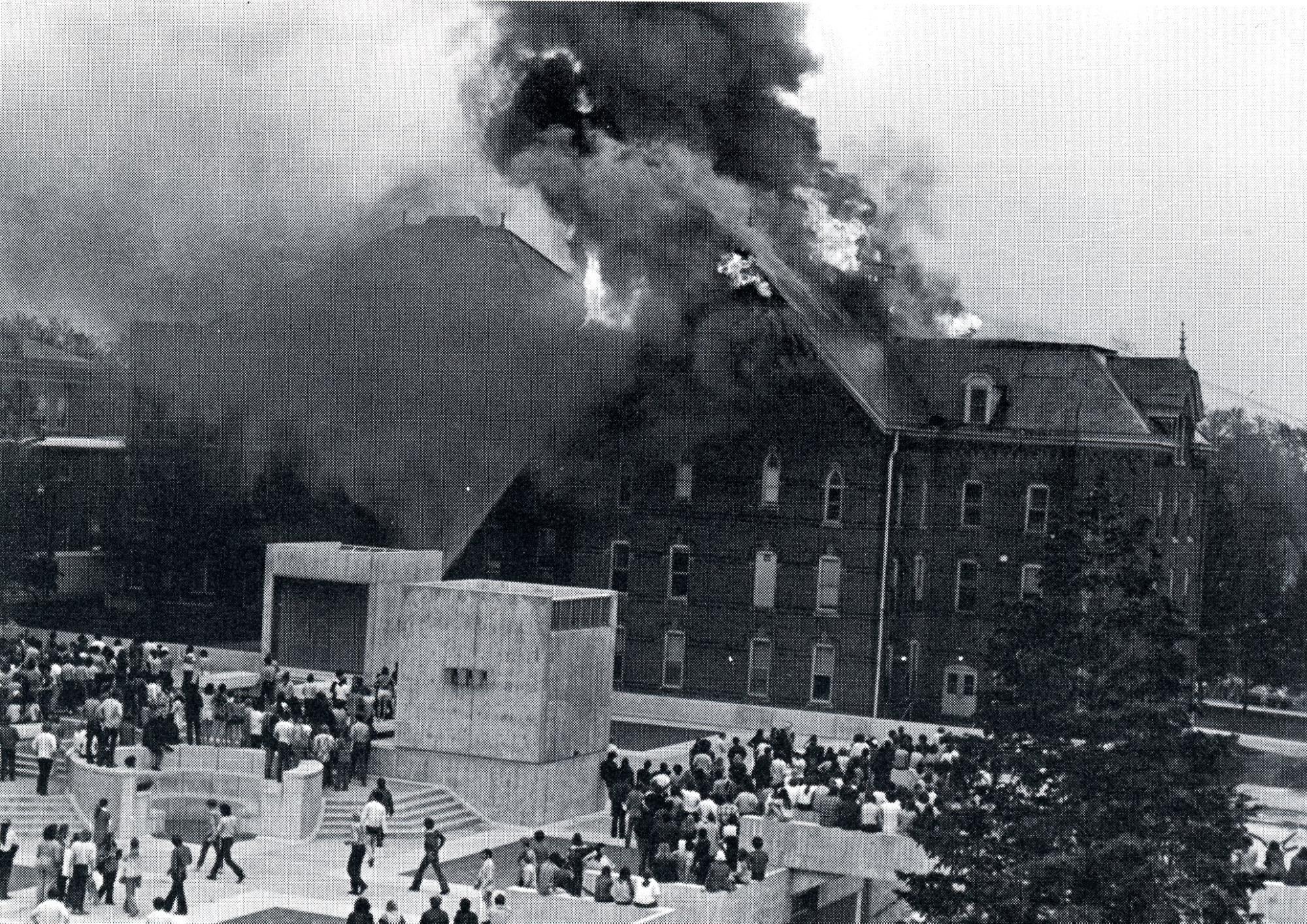
Students and faculty members managed to save some equipment and materials before the fire got out of hand.
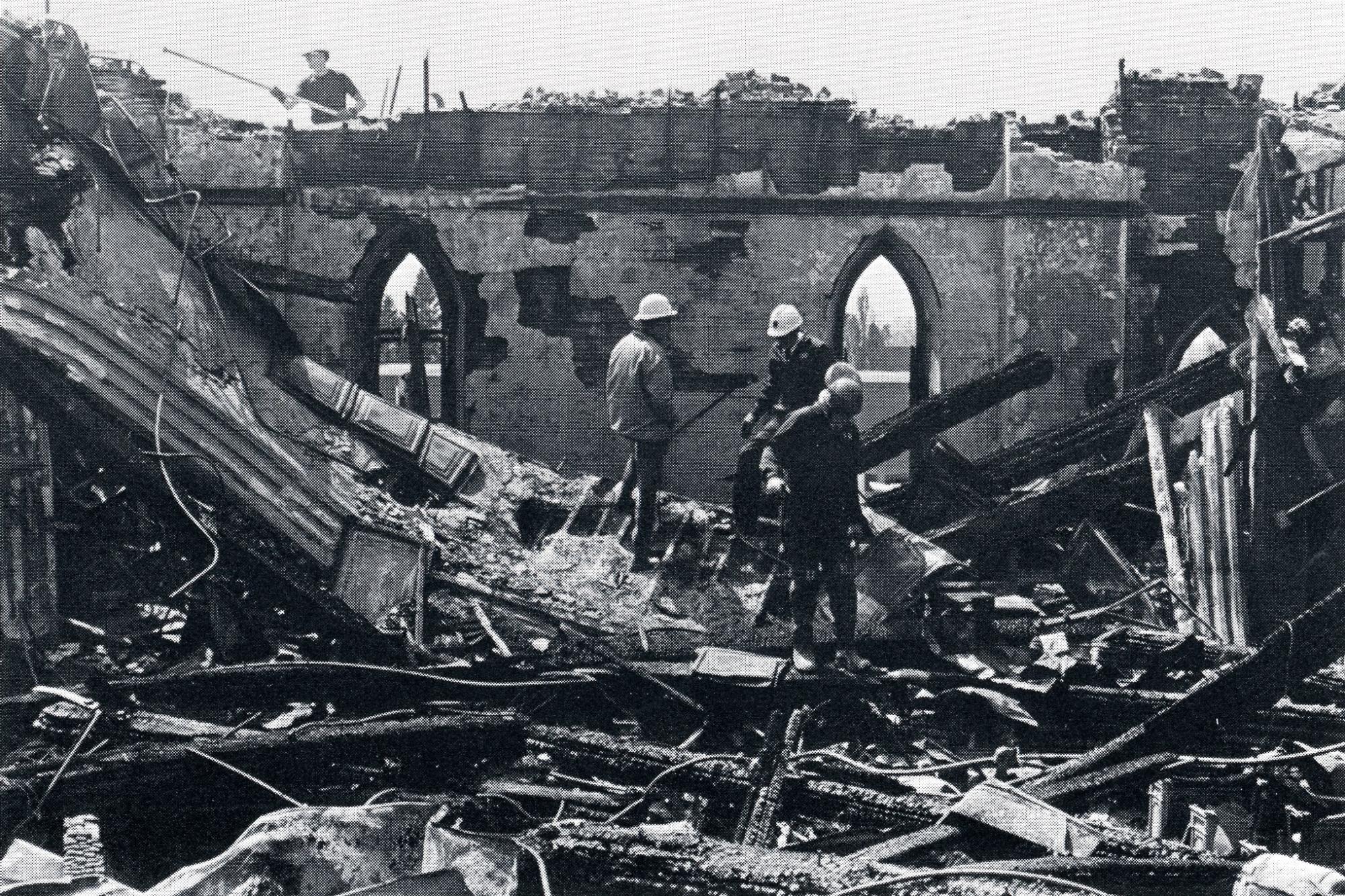

At the time of the Gilchrist Hall fire, the Educational Media Center, a planetarium, and the Behavioral Research Psychology Laboratory were located there. The Department of Curriculum and Instruction was also housed in Gilchrist Hall, along with offices for seventeen faculty members. The Media Center lost television equipment, but managed to salvage other audio-visual equipment as well as most of its film collection. Professor Gordon Harrington lost equipment and data from his laboratory. Faculty members lost the contents of their offices. The newly constructed planetarium was completely destroyed. In June 1972, the Regents approved UNI's request to set the fire loss at $1,095,525. They also let a demolition contract for $31,910. At that same meeting, the Regents passed a resolution of thanks to students and faculty who voluntarily dashed into the burning building to save books and equipment.
On September 3, 1972, as a crew was razing the building, workers discovered the cornerstone that had been laid back in 1882. Inside the cornerstone there was a metal box.
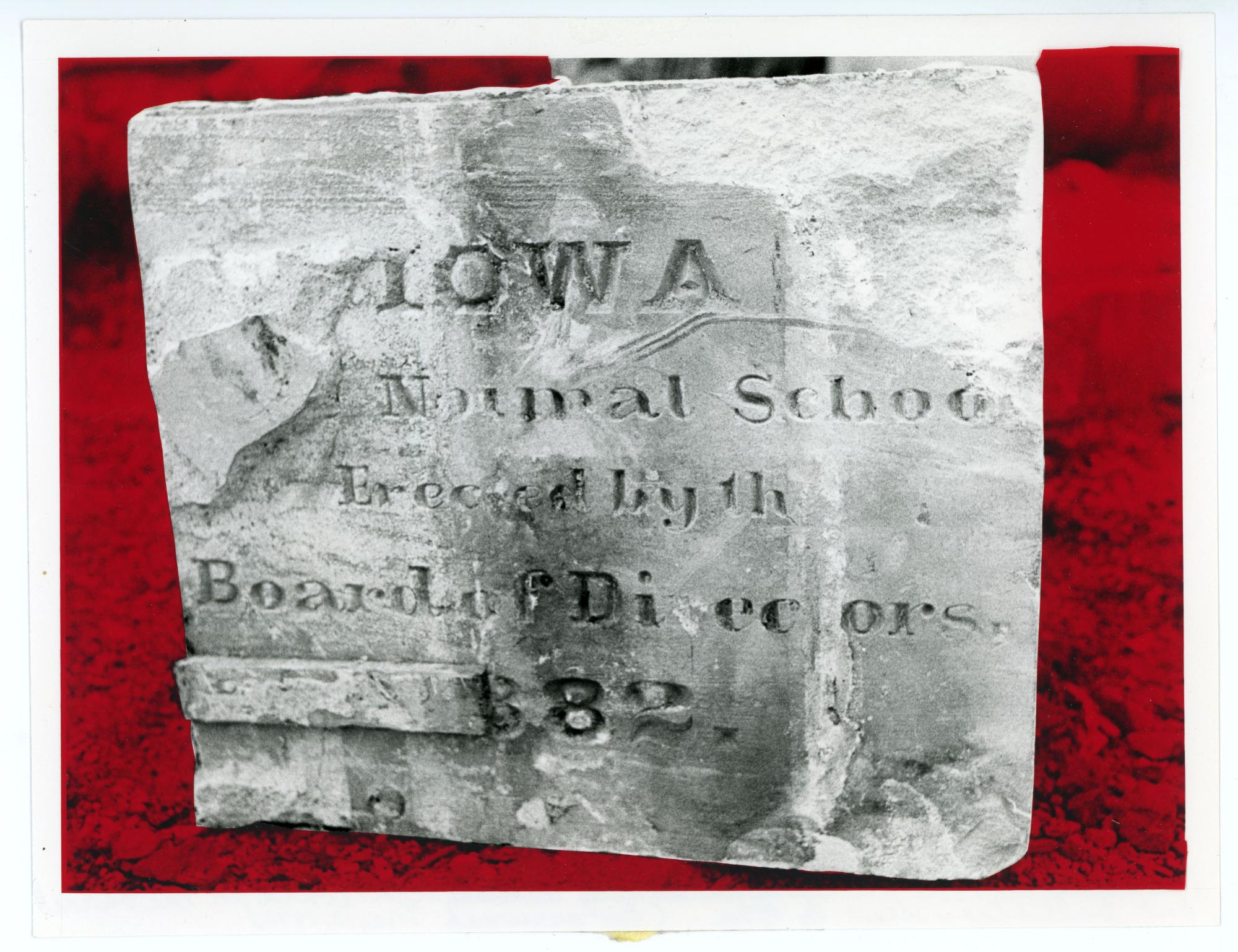
A formal ceremony was arranged on October 7, 1972, to open the cornerstone box. The ceremony opened with a carillon concert. Alumni Director Lee Miller introduced fifteen descendants of James Cleland Gilchrist, for whom the building was named. Professor William C. Lang talked about the historical background of the building and the university. Then, since members of the Masonic order had originally laid the cornerstone ninety years earlier, current Masons opened the box.

Sealed inside the box were many items from the school's early days. Included were Normal School catalogs, reports, the library catalog, rules and regulations, and a copy of the bill which established the Normal School in 1876. The Gilchrist Hall cornerstone contents are preserved in the Rod Library Special Collections and University Archives division. Following the ceremony, other historical memorabilia salvaged from the building, including dishes, keystones, and capstones, were sold at auction.
Compiled by Library Assistant Susan Witthoft; edited by University Archivist Gerald L. Peterson, Special Collections and University Archives, July 1996; substantially revised by Gerald L. Peterson, with scanning by Library Assistant David Glime, August 2006; last updated, July 28, 2015 (GP); photos and captions updated by Graduate Assistant Eliza Mussmann February 8, 2023.
